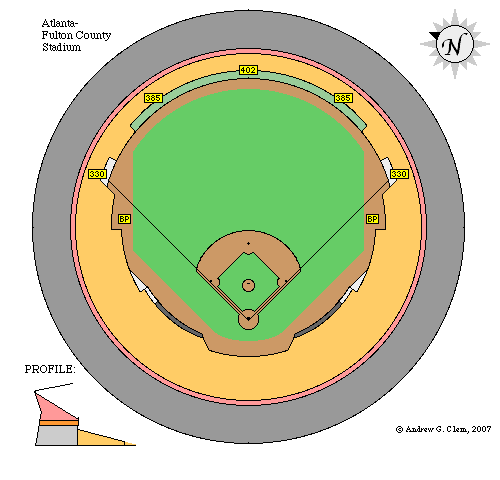ALL STAR GAME: 1972
BEEN THERE: Before a Braves game at Turner Field in 2001, I walked over to the parking lot where this stadium once stood.
This was one of the stadiums built "on speculation," paid for by taxpayers as part of a scheme to lure a baseball franchise from another city. Construction began in 1964 after the Milwaukee Braves owner promised to relocate his team to Atlanta. After construction on it was completed in 1965, the minor league Atlanta Crackers played at Atlanta Stadium (as it was known until 1975) while legal wrangling over the relocation of the Braves continued. This was the fourth circular hybrid stadium used in baseball (opening one month before Busch Stadium II), but it was the first such stadium without any large movable sections. In this simple cost-cutting configuration (which was later used in Oakland Coliseum as well), the football gridiron was laid out transversely, with the goalposts near the left field and right field corners rather than near home plate and center field, as in most other circular stadiums. During football games, about 25 extra rows of seats were installed in the outfield, and about eight rows of seats were added behind home plate as well. The 7,000 or so extra seats brought the total capacity for football games up to nearly 60,000. ALL seats were arranged in circular fashion. Net result: during baseball games as well as football games, thousands of fans sat far away from the action.
 The distance down the foul lines was 325 feet when the stadium first opened in 1966, but was increased to 330 feet a year later. In 1969, the outfield fence was moved in, reducing the distance to the power alleys by ten feet; the distance to center field was reduced by only two feet. Five years later (in 1974), the previous dimensions were restored. For some reason, there was a gap of about 15 feet between the fence and the "bleachers." An Indian teepee and "Chief Noc-A-Homa" (groan) occupied a part of this vacant space in left field beginning in 1967, and in 1978 the teepee was moved to a higher, more prominent position in the bleachers. One peculiarity of this stadium was that there was virtually no overhang between the upper and lower decks. (See photo at bottom.)
The distance down the foul lines was 325 feet when the stadium first opened in 1966, but was increased to 330 feet a year later. In 1969, the outfield fence was moved in, reducing the distance to the power alleys by ten feet; the distance to center field was reduced by only two feet. Five years later (in 1974), the previous dimensions were restored. For some reason, there was a gap of about 15 feet between the fence and the "bleachers." An Indian teepee and "Chief Noc-A-Homa" (groan) occupied a part of this vacant space in left field beginning in 1967, and in 1978 the teepee was moved to a higher, more prominent position in the bleachers. One peculiarity of this stadium was that there was virtually no overhang between the upper and lower decks. (See photo at bottom.)
Even though the power alleys were rather deep (except for 1969-1972), this stadium had a reputation for being friendly to batters, partly because it was the highest altitude major league baseball stadium (over 1,000 feet) until the Colorado Rockies began playing in Mile High Stadium in 1993. While the rest of the nation was "wallowing" in the Watergate scandal, Hank Aaron made this otherwise-forgetable stadium immortal on April 8, 1974 when he hit his 715th career home run, thereby surpassing Babe Ruth.
CINEMA: Several scenes from the motion picture The Slugger's Wife (1985), starring Michael O'Keefe and Rebecca De Mornay, were filmed here.
Under the ownership of ultra-ambitious cable television tycoon Ted Turner, the Braves gained the advantages of nationwide publicity and, in consequence, an ample payroll funded by advertising revenues. While Turner was married to Jane Fonda, the team attracted even more glamour and hype -- plus controversy over the "tomahawk chop" which the politically-correct Ms. Fonda grimly followed.
The Atlanta Falcons played football in this stadium from 1966 until 1991, after which they moved into the Georgia Dome. Ironically, this was the very moment when the Braves finally left behind their perennial losing ways and began their phenomenal streak of National League divisional championships -- winning the West Division from 1991 to 1993, and winning the East Division from 1995 to date. (The Montreal Expos were leading the NL East when the infamous players' strike of 1994 began.) In 1991 the Braves reached the World Series for the first time since 1958, did likewise the next year, and in 1995 they finally went all the way to become world champions for the first time since 1957.
The Braves' schedule was seriously disrupted by the 1996 Centennial Olympic Games in Atlanta. As workers began converting next-door Olympic Stadium into a baseball facility (Turner Field) that fall, the Braves made it to the World Series once again, as did the Yankees for the first time since 1981. It was a strange affair in which the first five games were won by the visiting team, including the last three games ever played in Atlanta-Fulton County Stadium. (The Yankees won the deciding Game 6 back home in the Bronx.) The former home of the Braves was demolished on August 2, 1997, and a parking lot now occupies that site. The diamond and foul lines are marked in brick, and bronze plaques indicate where the bases once were. In addition, the former outfield fence has been recreated as a monument to the glory days of "Hammerin' Hank" Aaron. There is a monument marked "715" that shows where his record-breaking home run landed, in front of a blue fence marking the perimeter of the old stadium.
SOURCES: Lowry (1992), Gershman (1993), Bisher (1966), www.sover.net/~hardybob/pictures.htm
FAN TIPS: Chris Kassulke, John Cappello


 Site map
Site map Photos!
Photos!

